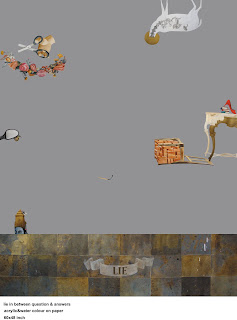Here is my latest article published in "Mail Today" newspaper in New Delhi for your reading pleasure. The Article was published on 26th March.
I see a lot of contemporary art shows opening every week, but there’s one that caught my eye recently, that too at a new space — Rasika Kajaria’s Exhibit 320 at Lado Sarai. What struck me was the cutting- edge work on display, especially that of Kundo Yumnam and Sandip Pisalkar, who made a scooter with a gas pipe that is also good for killing mosquitoes! Pisalkar first tried it out in a slum before putting it up at the show — well, the artists are getting bolder by the day.

On the art market, meanwhile, first sale of the spring season by Saffronart was being watched closely for pointers to the shape of things to come. The sale went by smoothly.
In the contemporary art space, there were no surprises and it was pretty much on predictable lines, except a work by Subodh Gupta that went for Rs 1.7 crore — it was a happy departure from the rates commanded by the artist in last year’s recession- hit market. Auctions in 2009 had seen his work go for Rs 80 lakh to Rs 1.1 crore.
A lot of galleries, collectors and investors ( including art funds) treat auction results as gospel truths and that is why data gets manipulated. The Indian contemporary art market does not have depth and is susceptible to manipulations. Already, Osian’s Art Fund has not been able to pay its investors. And I keep hearing complaints from people who are stuck with wrong valuations by the Copal Art Fund.
Let me give you some real- life examples of how easy it is to manipulate prices if an investor is keen on making a quick buck.
There is a prominent artist from Orissa who has also been shown in the country by the best Indian art galleries. When he started out around five years back, a group of art investors with a manipulative mindset picked him up at a standard rate of Rs 5,000 per square foot and bound him to a contract that required him to give all his work to his paymasters.
The investors then slowly started raising the prices in auctions.
The quality of the work was good and the investors had ample stock. The work was put up in an auction house, the bidding was taken to unrealistic heights by the investors’ friends, who bought a canvas each at every auction, and then these were sold through other auction houses at inflated prices. Their cost of buying their own possessions back was the 15 per cent buyer premium charged by the auction house and their entire stock got re- valued at a level that was seven times higher than the original.
Now this artist, because he was really good, got solo shows at prominent galleries and this further swelled the profits of the first batch of investors. The people who suffered were the later investors who followed auction prices and bought at ridiculous values, and collectors who genuinely liked the artist’s work and paid a price which he does not deserve till date. I saw his works even at the Saffronart auction and some people bought them at stretched valuations. That is how the art market works.
THIS happens all the time. I call some of these artists, auction artists — that is, they owe some part of their growth to friendly auction houses, which sometimes shut their faculties conveniently and sometimes also have a stake in the growing valuations of an artist. So the next time you read that screaming headline, ‘Indian art sets a new high’, don’t buy the hype: scratch the surface and probe deeper. Also, to get closer to the real value of the work of an artist, subtract the 15- 25 per cent buyer premium from the final value shown, for that is added on the final bid after the auction is closed.
Don’t get swayed by the valuation game. Check the background of an artist, be diligent about the research and probe the pricing logic. Also, whenever you intend to buy a canvas for over Rs 2 lakh, just buy from the best and well respected art galleries. In the particular case I have used as an illustration, you’d have still got taken for a ride, but in most cases you’d be protected, for even galleries have learnt from the past.
Auction houses Sotheby’s and Christie’s would have completed their sales by the time this article goes into print and although they have wonderful lots from the modern space, I wasn’t impressed with the contemporary works. All this price manipulation should not stop you from collecting, but don’t get taken for a ride! Buy what you like and only at the right price !
Kapil Chopra is Senior Vice President of Oberoi Hotels & Resorts.He writes a blog on collecting and investing in Indian Contemporary Art at www.indianartinvest.blogspot.com.He also writes for The Telegraph newspaper in the Sunday magazine " Graphiti" every fortnight. In Delhi, he writes for "The Mail Today " newspaper and "First City" magazine.













